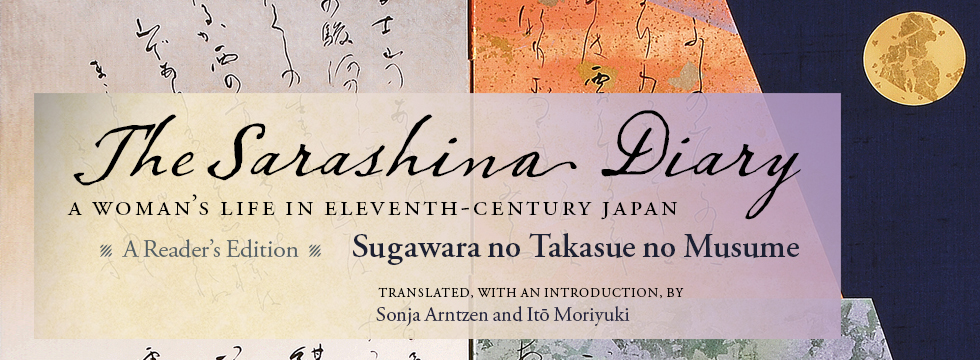The Marvels of the Sarashina Diary

“As the author herself says of Mount Fuji, this unique work ‘looks like nothing else in the world.’”
~David Damrosch, Harvard University
This week, we’ve been featuring works from Heian-era Japan, a period that produced an enormous amount of literature by women that would become part of the canon. Today, Sonja Arntzen reflects on her (and co-translator Moriyuki Itō’s) experience with The Sarashina Diary: A Woman’s Life in Eleventh-Century Japan. as teacher, reader, and translator. Arntzen’s essay follows our coverage on another literary classic from 11th-century Japan, The Pillow Book of Sei Shōnagon, where the author also emphasized her life as a writer and reader.
Enter or drawing for a chance to win a copy of The Sarashina Diary: A Woman’s Life in Eleventh-Century Japan (Reader’s edition). And follow #WITMonth for more guest posts about and excerpts of works by women in translation.
• • • • • •
It remains a marvel for me that, unlike anywhere else in the world, Japanese women a thousand years ago, long before any mass print culture, were highly literate, could consider their personal lives and inner thoughts worthy of recording, and had a community with which to share their writing. True, it was not all Japanese women, only those fortunate to have been born into the aristocratic society centered around the royal court, but small as its numbers may have been, that social group was large enough to spawn a genre of popular fiction and a significant body of life writing, most of it by women. That is why the author of the Sarashina Diary (ca. 1060) could choose to construct the story of her life around the pleasures and pitfalls of an addiction to reading fiction and the consolation of self-expression in the face of reality’s blows. Well aware of the works written decades before by other writers, she could weave allusions to them into her own work to create a web of subtle intertextual signification. Poetry was the most prestigious form of writing during her period and also an integral part of social interaction, so she centered much of her life story around moments that gave rise to poetry.
A second marvel is that such a text communicates relatively easily to contemporary readers. When early drafts of this translation were shared in several courses at the University of British Columbia, the students found her eminently “relatable” for various reasons. One surprising reason to me was that she did not base her life story around her relation to her husband or lovers but rather around the inner workings of her own mind. Students remarked that her diary felt like a “blog” in the sense that although the content was personal and seemingly spontaneous, one could sense the author shaping her story to reach out to unspecified others who might choose to “tune in” to her private world. This insight made me realize that the Sarashina Diary author did have something in common with contemporary bloggers, that, in a sense, she uses her personal life as a vehicle to attract readers. But her goal could not be the “15 minutes of fame” made possible by our frantic mass media world. Hers had to be a long game, hoping that her work would be copied and passed around even after her death so it might eventually have its poems noticed and included in imperial anthologies of poetry, which represented the pinnacle of literary value in her day. This did happen for her from the early 13th century on. In one sense, her diary may be considered a setting for her poems, the “serious” substance of her literary activity, but it turned out to be much more than that.
“Students remarked that her diary felt like a “blog” in the sense that although the content was personal and seemingly spontaneous, one could sense the author shaping her story to reach out to unspecified others who might choose to “tune in” to her private world.”
This translation has come out of its co-author Itō Moriyuki’s career-long devotion to the Sarashina Diary. Becoming entranced with the work as an undergraduate, he made it the subject of his graduate research. At an early stage in his studies, he read the English translation published by Ivan Morris in 1971. His own view of the author and the work were so different that he conceived a burning desire to see an English translation that would convey the beauty and complexity in the text that he and many other Japanese scholars could see. Where Morris saw a dreamy, timorous, almost pathologically immature author, Itō saw a sophisticated writer who skillfully deployed different personas for her narrative voice that range from the fantasy-struck girl to the wiser disillusioned matron. Morris surmised that most western readers would find the many poems in the work, “an annoying intrusion; banal, repetitive and often pointless,” Itō could not believe that was true, for if it were, there would be no hope for western readers to ever appreciate the diary in its fullness. His desire for a new translation with an introduction to do the author justice remained an “impossible dream” for many years.
Itō and I met at a conference in California in 1998. As he wrote in the afterword to our translation, “we realized that even in such a short time, we had been able to gain a deep understanding of each other’s views of literature and humanity,” which laid the foundation for our collaboration. In the subsequent years of our communication, the project was conceived. I was drawn to the project because I had recently translated another autobiographical work of the same period, the Kagerō Diary (University of Michigan Press, 1997) and I understood the need. We did not begin the work in earnest until 2005 when I retired. I thought that with two of us working on it, it might only take two years.
“Where Morris saw a dreamy, timorous, almost pathologically immature author, Itō saw a sophisticated writer who skillfully deployed different personas for her narrative voice that range from the fantasy-struck girl to the wiser disillusioned matron.”
Our joint translation and study of the Sarashina Diary came out in 2014. The positive reception to that volume encouraged the press to bring out in 2017, the Reader’s Edition, a stream-lined paperback at a reasonable price. The translation remained uncut, but we shortened the introduction by two thirds. Thus, the reader has the luxury of choice between the hard-cover with its detailed interpretative introduction or the softcover with only the essential information needed to appreciate the author, the work and her times. As we prepared this abridged version, Itō and I joked that we were letting the author speak more for herself, letting her out without a chaperon so to speak, confident now that she would not be misunderstood.
I want to conclude with remarking on my personal conversion to the e-book version of the Sarashina Diary: Reader’s Edition. I have resisted reading books on the tiny screens that abound in our age. But, for a research trip to Japan last fall, I actually purchased the e-book version of the Reader’s Edition for my phone, partly out of curiosity and to save packing the book. I was surprised to find it not only convenient but pleasant to use. One of the things we had to give up for the Reader’s Edition was having the copious notes on the facing page to the translation, which is much more reader-friendly than footnotes or endnotes. With the notes as hyper-links, that problem vanishes. For lack of a better word, it was also “fun” to be able to zoom into the illustrations and travel around inside them as it were. The formatting of the text sections presented no obstacles to absorption, even for me. Columbia University Press has earned numerous accolades for the designs of its books; perhaps it is time for the e-book designers to share in that glory.








